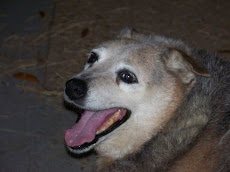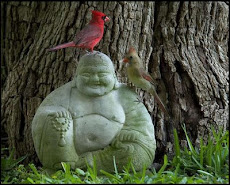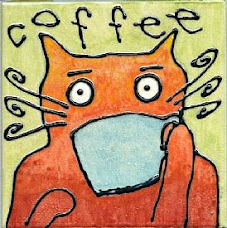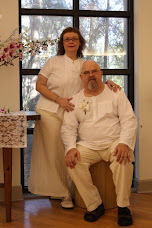Our blue heeler (Australian Cattle Dog) Lily went to "doggie heaven" last night. She was 13 years old. Lily was born in 1996 in Lacrosse, Florida, a small rural area located near Gainesville. When she was born, she was the largest puppy in the litter. I sometimes wondered over the years about what became of her litter mates, whether they were still living, where they were, and what kind of lives they had.
Lily's mother belonged to a gentleman who was a correctional officer and vocational instructor in the "Iron Triangle" of prisons (Florida State Prison, Union Correctional Institution, and New River Correctional Institution) in Bradford and Union Counties. His job involved training inmates to manage herds of cattle on state-owned pasture land, for a company called PRIDE (Prison Rehabilitative Industries Diversified Enterprises). Lily's mom worked in the fields with her owner. Lily's father belonged to a Jacksonville veterinarian who helped to formulate one of the popular brands of pet foods.
In her early years, Lily enjoyed herding a small group of polled Hereford beef cattle and Nubian milk goats in a rural area just west of Gainesville. She later moved with me into a Gainesville suburb, and transitioned from working dog to being a pet of leisure. She enjoyed long naps on our old brick patio under a Chinese elm, going for walks in the neighborhood, and protecting our home. Lily was terrified of fireworks, so New Years Eve and the Fourth of July were her least favorite days of the year. She was a bright dog, and worked out a deal with the Gainesville Regional Utilities meter reader to allow him into our backyard only in exchange for a Milkbone. True to her breed, she tried to nip the heels of most everyone who crossed her path. She loved tummy rubs, squeaky toys, and rawhide chewy bones.
Lily is survived by her human parents (Shelby and Jack), her 11 year old canine colleague JD (an Australian Shepard mix), and three cats, Bridget, Alice, and Sandy. Our home feels a bit empty, as this is the first day that I have ever lived in our house without her. I am sad that she is gone, and my life is certainly richer from having known and loved a blue heeler. As Buddhist friend Genkaku said, Lily, we will miss you to tears, but we thank you for the smile in our hearts.
Saturday, January 24, 2009
Thursday, January 15, 2009
Life in Poetry and Pastels
I plop down on our red leather sofa with a stack of catalogs I recently received in the mail. I put my feet up and start leafing through the catalogs. Several attractive outfits catch my eye in Lands' End and L.L.Bean. One particular item makes me do a double take. It is a baby doll style top, with short puffy sleeves and an empire waist. The fabric is a soft floral pattern with pastel blooms of pale pink, light aqua, and pear green. It looks like a style that my sister used to wear. It makes me feel a familiar twinge of missing her.
Carolyn has been gone more than a year now. I think I'm adjusting fairly well to the situation. Shortly after her death, New York City psychiatrist Dr. Ivan Goldberg, whom I have known for several years on an internet professional listserve, told me that he was depressed for long time after his sister's suicide. I have held his statement in my thoughts to remind myself over and over that when I'm feeling blue, my sadness will one day come to an end.
What kind of person was my sister? Like many other baby boomers, she loved Simon and Garfunkel music and long straight hair. She wore her hair in that same style from her college years until she was over fifty. Carolyn and I went to see Neil Diamond, another one of her music idols, in concert back in the 1980's. One year on my birthday, she sent me a little teddy bear holding a small silk balloon in one paw on which the words "You're Very Special" are printed. The bear stills sits on my bookshelf, reminding me of her.
Carolyn enjoyed poetry, especially the work of Emily Dickinson and Edna St. Vincent Milay. She was a university librarian for twenty-five years. She loved Granny Smith apples and Zero candy bars, and she hated cold weather. She adored Charlie Brown, Snoopy, and Siamese cats.
My big sister helped me in several ways over the years. She helped me get my first job, as a pharmacy technician at an Eckerds drug store, when I was a teenager. She had worked there as a cashier one summer when she was home from college, and she introduced me to the store manager. Although she was a Christian and believed in a male God, she gave me the first book I ever read on feminist spirituality, "When God Was a Woman" by Merlin Stone. When I got a divorce at age 30 and was struggling financially, she co-signed an application for an American Express card to help me rebuild my credit.
I should have known how things would turn out, but I’m not sure that I could have done anything to change the ultimate outcome. Carolyn had been in psychotherapy from time to time over the years, and had been prescribed antidepressants on a couple of occasions. During her last Christmas, in 2006, she sent me a prized work of art as a gift, something I thought she would never give away. It is a Georgia O'Keeffe inspired abstract of a cow skull, done by the late Alabama artist Anne Ward Huey who died in 1988 from lupus-related kidney failure. Carolyn married Anne's widower in 1990. Their marriage lasted 17 years. The two of them shared an appreciation of the late Anne's art. They were in the processess of divorcing when my sister died. Carolyn did not want the divorce.
In a phone conversation in early 2007, Carolyn told me unexpectedly that she was going to repay me a long outstanding personal loan of a thousand dollars, and sent me a check in the mail a few days later. Maybe she was getting her affairs in order and this, too, was a sign of what was to come, but I failed to recognize it at the time. She seldom complained about her marital problems, and I did not know until until after her spouse left her in September, 2007 that he had threatened to do so many times throughout their marriage, beginning right after their wedding in 1990.
Both Carolyn and her spouse were Enneagram Type Two. The Enneagram is a theory of personality development written by the Sufis over a thousand years ago. According to this theory, people become one of nine personality types, based on their early experiences.
Type Twos, known as the Helper or the Giver, are described by Enneagram teacher Renee Baron, as being motivated by the need to be loved, appreciated, and needed. They take pride in their ability to make people feel special and to anticipate and to fulfill other people’s needs better than anyone else. Twos appear cheerful, self-sufficient, and confident, and are often unaware of their own needs. Healthy Twos are warm, generous, empathic, enthusiastic, and nurturing, They relate easily to people, enjoy giving to others, and are capable of unconditional love. Unhealthy Twos can be manipulative, clingy, indirect, possessive, martyrlike, and preoccupied with gaining approval.
Carolyn helped her husband a great deal in the early years of their relationship when he was going through some difficult times with his health and his career. She came to the rescue in a big way, shouldering most of the responsibility for the couple's obligations and living expenses. In the last years of their marriage, when Carolyn needed assistance and expected a return on her investment, her spouse didn't want to reciprocate. Family members postulated after her death that Carolyn may have been manipulatively self-sacrificial about the help she had given him. When her spouse later found himself in the position of being expected to help his helper, he didn't want to be there for her and bailed out of the marriage. Enneagram expert Don Riso describes the relationship between a pair of unhealthy Twos as a "macabre dance of death". The outcome of this dance was my sister's death.
When the tree was removed, it left a stump about three feet in diameter. Over time, the stump rotted and tall green bamboo shoots grew up around it. Yesterday I peered through the bamboo shoots and found the splintered remnants of the decayed stump.
I guess I didn't notice changes in my world over time, like the sweet gum stump decomposing and my sister's distress exceeding her ability to cope. Carolyn preferred living in a dreamy world of poetry and pastels, and to paraphrase Don Riso paraphrasing Othello, she didn't love too wisely or too well. She didn't want to think about things like making a "Plan B" for her life if her marriage didn't work out.
I struggle to find peace and meaning around the whole situation, and sometimes I still can't quite believe that Carolyn is gone. Life is fragile and we never know what the future will bring. Although I'm adapting to life without a sister, I'm still trying to find ways to put her death into perspective. I think my journey along this path will be long before I find a way to completely heal the loss.
Carolyn has been gone more than a year now. I think I'm adjusting fairly well to the situation. Shortly after her death, New York City psychiatrist Dr. Ivan Goldberg, whom I have known for several years on an internet professional listserve, told me that he was depressed for long time after his sister's suicide. I have held his statement in my thoughts to remind myself over and over that when I'm feeling blue, my sadness will one day come to an end.
What kind of person was my sister? Like many other baby boomers, she loved Simon and Garfunkel music and long straight hair. She wore her hair in that same style from her college years until she was over fifty. Carolyn and I went to see Neil Diamond, another one of her music idols, in concert back in the 1980's. One year on my birthday, she sent me a little teddy bear holding a small silk balloon in one paw on which the words "You're Very Special" are printed. The bear stills sits on my bookshelf, reminding me of her.
Carolyn enjoyed poetry, especially the work of Emily Dickinson and Edna St. Vincent Milay. She was a university librarian for twenty-five years. She loved Granny Smith apples and Zero candy bars, and she hated cold weather. She adored Charlie Brown, Snoopy, and Siamese cats.
My big sister helped me in several ways over the years. She helped me get my first job, as a pharmacy technician at an Eckerds drug store, when I was a teenager. She had worked there as a cashier one summer when she was home from college, and she introduced me to the store manager. Although she was a Christian and believed in a male God, she gave me the first book I ever read on feminist spirituality, "When God Was a Woman" by Merlin Stone. When I got a divorce at age 30 and was struggling financially, she co-signed an application for an American Express card to help me rebuild my credit.
I should have known how things would turn out, but I’m not sure that I could have done anything to change the ultimate outcome. Carolyn had been in psychotherapy from time to time over the years, and had been prescribed antidepressants on a couple of occasions. During her last Christmas, in 2006, she sent me a prized work of art as a gift, something I thought she would never give away. It is a Georgia O'Keeffe inspired abstract of a cow skull, done by the late Alabama artist Anne Ward Huey who died in 1988 from lupus-related kidney failure. Carolyn married Anne's widower in 1990. Their marriage lasted 17 years. The two of them shared an appreciation of the late Anne's art. They were in the processess of divorcing when my sister died. Carolyn did not want the divorce.
In a phone conversation in early 2007, Carolyn told me unexpectedly that she was going to repay me a long outstanding personal loan of a thousand dollars, and sent me a check in the mail a few days later. Maybe she was getting her affairs in order and this, too, was a sign of what was to come, but I failed to recognize it at the time. She seldom complained about her marital problems, and I did not know until until after her spouse left her in September, 2007 that he had threatened to do so many times throughout their marriage, beginning right after their wedding in 1990.
Both Carolyn and her spouse were Enneagram Type Two. The Enneagram is a theory of personality development written by the Sufis over a thousand years ago. According to this theory, people become one of nine personality types, based on their early experiences.
Type Twos, known as the Helper or the Giver, are described by Enneagram teacher Renee Baron, as being motivated by the need to be loved, appreciated, and needed. They take pride in their ability to make people feel special and to anticipate and to fulfill other people’s needs better than anyone else. Twos appear cheerful, self-sufficient, and confident, and are often unaware of their own needs. Healthy Twos are warm, generous, empathic, enthusiastic, and nurturing, They relate easily to people, enjoy giving to others, and are capable of unconditional love. Unhealthy Twos can be manipulative, clingy, indirect, possessive, martyrlike, and preoccupied with gaining approval.
Carolyn helped her husband a great deal in the early years of their relationship when he was going through some difficult times with his health and his career. She came to the rescue in a big way, shouldering most of the responsibility for the couple's obligations and living expenses. In the last years of their marriage, when Carolyn needed assistance and expected a return on her investment, her spouse didn't want to reciprocate. Family members postulated after her death that Carolyn may have been manipulatively self-sacrificial about the help she had given him. When her spouse later found himself in the position of being expected to help his helper, he didn't want to be there for her and bailed out of the marriage. Enneagram expert Don Riso describes the relationship between a pair of unhealthy Twos as a "macabre dance of death". The outcome of this dance was my sister's death.
I am learning to deal to the fact that life can bring us changes that we don't see coming and do not want. I thought that I would have my sister for a lot longer. I didn't want to go through life without a sister, but I found myself without her at age 49. She was never really able to share with me the true depth of her anguish about her marriage.
Some changes are gradual and creep up on us over time. In our backyard yesterday, I was surprised to notice that a very large tree stump was missing. I had a 70 foot tall sweet gum tree cut down in 2002, because the lawn was often covered with so many prickly balls that my dogs couldn't romp without stepping on them and ending up with sore paws. I was sad to see the huge tree go. The original owner of our mid-20th century modern style house, a University of Florida architecture professor from Switzerland, planted it when he built the house in 1957.When the tree was removed, it left a stump about three feet in diameter. Over time, the stump rotted and tall green bamboo shoots grew up around it. Yesterday I peered through the bamboo shoots and found the splintered remnants of the decayed stump.
I guess I didn't notice changes in my world over time, like the sweet gum stump decomposing and my sister's distress exceeding her ability to cope. Carolyn preferred living in a dreamy world of poetry and pastels, and to paraphrase Don Riso paraphrasing Othello, she didn't love too wisely or too well. She didn't want to think about things like making a "Plan B" for her life if her marriage didn't work out.
I struggle to find peace and meaning around the whole situation, and sometimes I still can't quite believe that Carolyn is gone. Life is fragile and we never know what the future will bring. Although I'm adapting to life without a sister, I'm still trying to find ways to put her death into perspective. I think my journey along this path will be long before I find a way to completely heal the loss.
Thursday, January 1, 2009
A Happy New Year
When I was a child, my paternal grandparents, who were Disciples of Christ ministers in the hills of Eastern Kentucky, were among my favorite people. To me, they represented everything about the world that was good and true and kind. I saw them as being vitally important to their small rural community. There were no psychotherapists in those parts and Prozac hadn’t been invented yet. Whenever a parishioner became ill, their tobacco crop failed, or their tractor broke down, my grandparents were always there to help. I remember seeing my grandfather hike down the hill from the parsonage to make pastoral visits at Marymount Hospital in the mornings, and I watched him write his sermons as he sat at his big oak roll top desk. My grandmother taught a Bible Study class on Wednesday evenings, and she even had her own radio show on a Christian station for awhile, providing messages of hope and comfort for listeners. She tirelessly cranked out bulletins for the Sunday services on an old mimeograph machine in the church basement, and sometimes she would let me help her pick out beautiful images of religious art for the bulletin cover. I saw their work as being the most important thing in the world.
My grandparents met each other in a holler known as Grassy Creek, when she was 16 years old and he was 17. They got married and started having kids. Many years after they had passed away, I found out something very interesting about them. My grandfather wanted to be a farmer, but he didn’t have any money to buy land. My uncle Jim, one of their three sons, told me that when he was a small child, he remembered seeing them sitting together at their kitchen table, leafing through college catalogs and trying to choose a course of study. They decided to enroll together in Lexington Theological Seminary to earn their ministerial degrees.
So I realized that they didn’t receive a divine calling to be ministers. Their decision to spend their lives serving a faith community was voluntary rather than demanded of them by a supreme being. It was a conscious choice. As a liberal Unitarian Universalist, this insight made me appreciate my grandmother and grandfather even more.
I am a continuation of my grandparents. Although my chosen profession is in the healthcare field rather than the ministry, I hope someday to provide spiritual care for others. Jack and I got out of bed early this morning, and drove a bit bleary-eyed to a Tibetan Buddhist First Light New Years Ceremony, where we meditated, chanted, and lit 108 beautiful candles with a small group of people. In this type of ceremony, prayers for peace are made at the beginning of the first day of the new year. With groups participating worldwide, Buddhists greet the first light across the planet in a continuous wave of prayer. I cannot think of a more important or meaningful way to spend New Years Day. Whenever I engage in spiritual practices, I feel my close to my grandparents, I am peaceful and happy, and all is right with my world.
Peace and Happy New Year to all!
My grandparents met each other in a holler known as Grassy Creek, when she was 16 years old and he was 17. They got married and started having kids. Many years after they had passed away, I found out something very interesting about them. My grandfather wanted to be a farmer, but he didn’t have any money to buy land. My uncle Jim, one of their three sons, told me that when he was a small child, he remembered seeing them sitting together at their kitchen table, leafing through college catalogs and trying to choose a course of study. They decided to enroll together in Lexington Theological Seminary to earn their ministerial degrees.
So I realized that they didn’t receive a divine calling to be ministers. Their decision to spend their lives serving a faith community was voluntary rather than demanded of them by a supreme being. It was a conscious choice. As a liberal Unitarian Universalist, this insight made me appreciate my grandmother and grandfather even more.
I am a continuation of my grandparents. Although my chosen profession is in the healthcare field rather than the ministry, I hope someday to provide spiritual care for others. Jack and I got out of bed early this morning, and drove a bit bleary-eyed to a Tibetan Buddhist First Light New Years Ceremony, where we meditated, chanted, and lit 108 beautiful candles with a small group of people. In this type of ceremony, prayers for peace are made at the beginning of the first day of the new year. With groups participating worldwide, Buddhists greet the first light across the planet in a continuous wave of prayer. I cannot think of a more important or meaningful way to spend New Years Day. Whenever I engage in spiritual practices, I feel my close to my grandparents, I am peaceful and happy, and all is right with my world.
Peace and Happy New Year to all!
Subscribe to:
Comments (Atom)














.jpg)


































